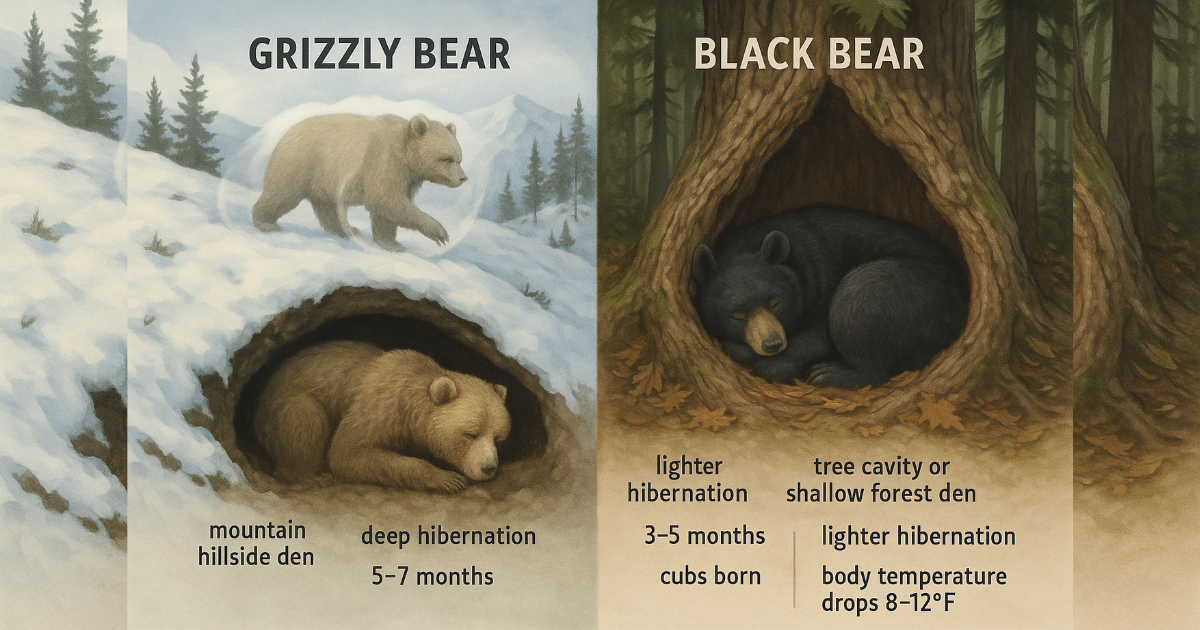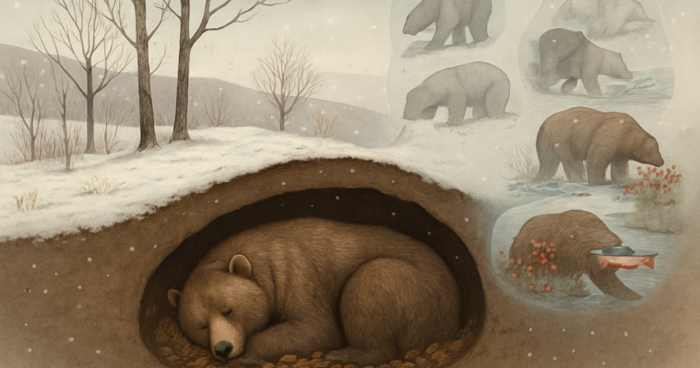Bear denning and hibernation: typical behavior in Alaska reflects an extraordinary evolutionary adaptation to extreme conditions. As winter tightens its grip on Alaska’s vast and rugged landscape, both brown and black bears retreat into dens to conserve energy and survive months without food. Hibernation is not just sleep, it’s a sophisticated physiological and behavioral strategy finely tuned by seasonal behavior and environmental cues. These adaptations are central to wildlife survival in winter and vary depending on species, geography, and even gender. In this guide, we’ll explore how denning works, what triggers it, and how Alaska’s iconic bear species respond differently to the cold season.
What Is Winter Dormancy in Bears?
Winter dormancy in bears, often referred to as hibernation, involves complex physiological changes that drastically reduce the bear’s energy expenditure. Unlike smaller mammals that experience deep, continuous hibernation, bears enter a state closer to torpor, marked by lower metabolic activity but occasional movement or responsiveness to stimuli.
This inactive metabolic state allows bears to survive harsh winters without eating, drinking, or eliminating waste. Brown and black bears show species-specific behavior: while both enter dormancy, black bears are known for slightly lighter torpor, sometimes even emerging briefly if disturbed or during milder spells. These behaviors reflect finely tuned energy conservation mechanisms evolved over millennia.
Inside the Alaskan Bear Hibernation Cycle
The bear denning and hibernation cycle in Alaska begins as early as October and can last through April, depending on elevation and latitude. As temperatures drop and food becomes scarce, bears enter dens dug into hillsides, under tree roots, or within natural caves. Once inside, they begin a remarkable physiological transformation to endure months of inactivity.
The Alaskan bear hibernation cycle unfolds in phases: entry, dormancy, and emergence. Entry is triggered by shortening daylight and dropping temperatures. Dormancy sets in with a steep decline in activity, while emergence typically follows rising spring temperatures and increasing daylight, nature’s cues for renewal.
Bear metabolic changes during hibernation are profound. Heart rate slows from 40–50 beats per minute to just 8–10. Body temperature drops slightly, but remains high enough to avoid freezing. Fat reserves sustain the body while muscles and organs are preserved with minimal loss, an incredible display of biological efficiency.
Grizzly Bear Denning Habits vs. Black Bear Behavior

Grizzly bear denning habits in Alaska typically involve choosing high-elevation sites with deep snow accumulation, which helps insulate dens. Grizzlies begin denning earlier, often by mid-October, and stay dormant longer, reflecting their adaptation to colder, more remote regions. They also tend to dig solitary dens in steep terrain, sometimes several feet deep.
Black bear winter behavior differs in several ways. Black bears often choose lower-elevation sites, including hollow trees, root systems, or dense thickets. Their hibernation periods are usually shorter, particularly in southern or coastal areas where winter is less severe. Black bears may even wake briefly during warmer spells, especially females with cubs.
These behavioral differences highlight broader species comparison dynamics influenced by habitat, latitude, and body size.
👉 To explore more differences between these species beyond denning habits, check out our article on brown bear vs grizzly bear.
Den Site Selection in Alaska
Den site selection in Alaska is shaped by terrain, snow depth, elevation, and protection from predators or environmental disturbance. Grizzlies often excavate dens into hillsides or ridgelines with good drainage, while black bears use existing tree cavities or ground dens covered in thick vegetation.
Temperature regulation in bear dens is critical. The insulating effect of deep snow (the subnivean layer) and strategic site choice help maintain a stable microclimate inside the den, keeping temperatures just above freezing. This thermal insulation minimizes energy loss during hibernation and supports survival through extreme cold.
The Role of Pregnant Bears in Dens
Pregnant bears in dens play a vital role in species continuation. Females enter hibernation already pregnant, but due to delayed implantation, the embryo does not attach to the uterus until conditions are ideal. Cubs are born mid-winter, usually in January, while the mother remains dormant.
This remarkable feat includes bear cub birth, lactation during hibernation, and complete maternal care, all while the mother doesn’t eat, drink, or eliminate waste. Maternal denning ensures that cubs are kept warm and nourished until they are strong enough to emerge in spring.
Bear Emergence and Spring Behavior
Bear emergence in spring varies by region, elevation, and bear type. Typically, adult males are the first to leave dens, followed by females without cubs. Mothers with cubs are the last to emerge, ensuring the young are strong enough to travel and forage.
Hibernation duration by species also varies. Grizzlies in higher elevations or northern zones may hibernate for up to 7 months, while black bears in coastal or southern areas may spend as little as 3–5 months in dormancy. Post-hibernation foraging begins almost immediately as bears replenish lost weight and respond to seasonal rhythms like daylight and food availability.
Conclusion
Bear denning and hibernation in Alaska represent some of the most extreme survival adaptations seen in the animal kingdom. These behaviors are finely tuned to the state’s diverse environments and demanding winters. From metabolic shutdowns to maternal denning, bears have evolved intricate systems for enduring long months of scarcity and cold.
Learn more about the physical and behavioral differences between these bears in our main guide: brown bear vs grizzly bear.


